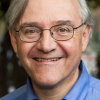Reverend Mark Trotter
Former Senior Minister – First United Methodist Church of San Diego
 On the occasion of our “reunion,” Michael and I decided to talk about stories about religion currently in the news. Most recently in newspapers was the report from the Pew Forum On Religion, which revealed that those with no religious affiliation reached a new high of 20% of the adult U.S. population. That has been called, “the rise of the nones,” which sounds like the Catholic nuns have stormed the Vatican, but in “newspeak” the “nones” refer to those who answer “none” when asked about their religious affiliation.
On the occasion of our “reunion,” Michael and I decided to talk about stories about religion currently in the news. Most recently in newspapers was the report from the Pew Forum On Religion, which revealed that those with no religious affiliation reached a new high of 20% of the adult U.S. population. That has been called, “the rise of the nones,” which sounds like the Catholic nuns have stormed the Vatican, but in “newspeak” the “nones” refer to those who answer “none” when asked about their religious affiliation.
The other part of the Pew Report that got attention is, that for the first time in American history the Protestants are no longer in the majority. In the last Pew poll, in 2007, the Protestants were at 60% of the population, today they are at 48%. The report also stated that most of the “nones” had some twinges of transcendence, vague religious feelings, but left them unexplored, which could also be a description of the spiritual life of many Protestants still on church rolls. Previous polls have uncovered Protestants have a vast ignorance of their heritage. A Methodist challenged a Presbyterian, “I’ll bet you $5 you can’t recite the Lord’s Prayer.” The Presbyterian replied, “Yes I can. ‘Now I lay me down to sleep/ I pray the Lord my soul to keep’.” The Methodist said, “Here’s your $5. I didn’t think you could do it.”
The Pew report listed four possible causes of “unaffiliation.” One was the delay of marriage and the consequent delay in having children, which made sense because most of the unaffiliated are from twenty to forty years old. It has been my experience that young people who have been raised in the church take a leave of absence when they are first on their own, but many come back when they get married and start a family. People are getting married and starting families at least ten years later than they did when I started performing marriages. Fifty years ago most people got married in their early twenties, today they are in the late twenties and thirties before they marry. Having children is a way of experiencing the miracle of human life, and elicits feelings that life is not merely the result of biology, but is a miracle, a gift. In addition, raising children confronts you with the limitation of your own powers. Both the awe birth and the humility that comes with parenting, lead people back to religion.
The second reason given for the rise of the “nones,” is the “bowling alone” syndrome outlined by Robert Putnam in his book of the same name. Putnam’s book documented the decline in participation in community organizations. It is obvious that if there is a detachment of younger people from community, the local church will be affected as well.
The third cause is the secularization of society. On one level that refers to the absence of religious symbols and gestures in the public square; on another, the disappearance of reference to God in order to explain things. Secularism began in the Enlightenment in the 17th and 18th centuries and has steadily shaped the world ever since. In a famous incident, Napoleon listened to the French mathematician, La Place, explain his mathematical model of the solar system. He asked, “Where is God in this?” La Place famously replied, “I have no need of that hypothesis.” That is secularism; the absence of God as a vital part of the world, and I would think a major reason for the rise of the nones.
But I want to talk in more detail about Pew’s fourth reason for “unaffiliation,” which was listed in the report as “political backlash,” and spelled out as reaction against the religious right. Mainline Protestant churches have traditionally respected the separation of church and state; right wing, or fundamentalist churches have not, and that is what “nones” object to.
But not only is there a rise of the “nones” in our time, there is also a rise of the religious right, which is what I want to address in more depth.
In 1992, Samuel Huntington, professor of political science at Harvard, published a book entitled, The Clash of Civilizations. The message of the book was that the end of the Cold War did not mean the end of conflict in the world. The end of the Cold War simply cleared the stage for a new, prolonged, and equally dangerous conflict between east and west. This time the conflict would not be over political ideology, but over religion, specifically Islam against Christianity.
I didn’t like Huntington’s book. My principal objection was that he seems to equate all religion with fundamentalism. There are two billion Muslims in the world. I doubt that many more than a fraction are fundamentalists ready to go to war against the west. There are also two billion Christians, and the same could be said about them.
In spite of that objection, Huntington’s analysis of why some religious become fundamentalist is very helpful. He says when civilizations feel their values and way of life are threatened, they turn to the center, and the center of all civilizations is religion. So when under siege people do three things.
1. Declare those doctrines that give them identity and bring meaning
to their lives, infallible
2. Declare their sacred scripture, the source of their beliefs, inerrant
3. And treat all who don’t share their beliefs as infidels
I think you will agree that description defines the Islamic fundamentalist. I want to suggest it can also help us understand American fundamentalism. The use of the term “fundamentalist” began in America. It was worn proudly by those Protestant Christians who left the mainline churches and formed their own churches because they believed the mainline churches had been seduced by “modernism.” Modernism can be defined as openness to the radical changes occurring in the 19th century, particularly in science. What fundamentalists objected to specifically was the use of reason in interpreting scripture, and the acceptance of the Darwinian theory of evolution. Both directly challenged the inerrancy of scripture. Therefore fundamentalists believed modernism was apostasy, so they separated themselves to preserve the fundamentals of Christian faith.
There eventually evolved five fundamentals. The most important of the five, and always the first listed, is the inerrancy of scripture. Incidentally another one of the five is the imminent return of Jesus, which fundamentalists believe will happen in Jerusalem. Thus the unlikely, and in the opinion of some, the unholy alliance, between fundamentalists and Israel. Which reminds me of the good news – bad new story. The good news is Jesus has returned. The bad news is he is in Salt Lake City.
The movement quickly spread, and by the 1920’s it had a significant presence in American life, embraced perhaps by a majority of the population. But it was ridiculed and pilloried by the press, and devastatingly by H.L. Mencken, one of the most influential columnists in the nation.
In 1925 a teacher in Clinton, Tennessee named John Thomas Scopes was put on trial for teaching Darwin in the public school. Thanks to the newspapers the trial became a national spectacle. William Jennings Bryan, three time candidate for president, the nation’s greatest orator, and a fundamentalist of sorts, volunteered to prosecute the case. Clarence Darrow, the nation’s most famous trial lawyer, and an atheist of sorts, volunteered to defends Scopes. The event had nothing to do with Scopes. It had to do with the clash of cultures; the world of fundamentalism vs the modern world. It was obvious that Darrow defeated Bryan. In fact he humiliated him, ridiculed him.
But the Scopes trial did not get rid of fundamentalism. The press just stopped paying attention to it. Fundamentalism went underground, out of sight, and continued to thrive in thousands of small towns across the country, nurtured by thousands of little radio stations with fundamentalist preachers broadcasting twenty four hours a day.
Now remember the Huntington thesis. When people feel their way of life is threatened they turn to the center and make their beliefs infallible and their scripture inerrant. The humiliation came from the press in the 1920s; the assault on their values in the 1960s. Liberals generally hailed the sixties as a time of victory for free speech, civil rights, women, and later for gays. Fundamentalism saw the sixties as an attack on the American way of life.
Prior to 1960, fundamentalism was associated with radio preachers; after 1960 it is associated with television, making Jerry Falwell and Pat Robertson the best known fundamentalists in the nation.
In the 1970’s fundamentalists organized politically in what was called the “moral Majority.” Now saving America, or restoring America to what they believe it was before the liberals, became virtually another of the “fundamentals.” And though the Moral Majority no longer exists, the voting block they organized does. Today fundamentalist churches are actively involved in partisan politics seeking to restore the values they believe define America.
There is in Native American culture a position named “story teller.’ The storyteller’s job is to tell the stories that define the nation; who they are, why they are here, what life is all about. Harvey Cox pointed out that every culture has storytellers. They are essential to the preservation of the values of the nation. In the America I grew up in it was universally recognized that there were three institutions that had to responsibility of storytellers. Those three institutions were the family, the church and the school. Ask yourself who tells the stories in our society today? Who teaches the young about values, about the meaning of life, about what it means to be a man or a woman. I suggest it’s the media in its multiple forms. That is why the life of a fundamentalist centers in the family, the church, and the Christian school, or the home school, because they feel besieged in the modern world, and they aim to change it.
All this concerns me for this reason; fundamentalists believe that America was founded as a Christian nation and they are called to restore that heritage. I remind you they do not believe in the separation of church and state, and they are engaged in efforts to find representatives who share that view. In that regard I suggest there is no difference between Islamic and Christian fundamentalists. They both believe that religion, their religion, should define the laws that govern the nation.
Dorothy Sayers wrote, “The first thing a principle does is rise up and kill someone.” She was referring to those who believe that others should conform to what they believe. History is full of such stories, most of them about religions when they have the power of the state behind them.
So I am concerned less about the nones than about the rise of the fundamentalists either in Islam or Christianity.





